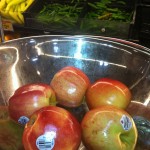
- Image via Wikipedia
There are 3 healthy lifestyles that add up to big bucks, but eating well doesn’t have to cost a fortune. There are several things you can do to reduce your budget on even the healthiest of foods.
Fresh meat and produce make up the largest portion of a healthy food budget. The key here is to buy what is on sale. Use the grocery ads to plan your menu around the meat & vegetables you can get on sale. If your family enjoys fresh fruit, buy the advertised specials each week. You may not get apples and bananas every week, but you can still have a variety of food to choose from.
Organic produce can also be costly, but the same principles apply. Another way to save on organic foods is to purchase organic only for those foods with the highest risk factors for pesticides.
- Apples/Pears
- Peaches/Nectarines
- Celery
- Cherries
- Strawberries
- Grapes
- Spinach
- Potatoes
- Bell Peppers
- Raspberries
- Asparagus
- Avocados
- Bananas
- Broccoli/Cauliflower
- Corn
- Kiwi
- Mangoes/Papaya
- Onions
- Pineapples
- Sweet Peas
Expensive food choices also occur when your medical history requires a special diet. Again, the key is to buy the foods you need when they are on sale, even if you don’t need them yet. It is usually unnecessary to make a separate trip to a health food store. Meijer has a wide variety of lifestyle diet foods, such as gluten-free and low-carb available. Kroger and Marsh also carry these specialty items in their organic foods section. If you can’t find what you are looking for in your local store, ask to speak to a manager who can point you in the right direction or look up the availability of your needed groceries. While you are doing your regular shopping, stop by the department that carries your specialty food to watch for sale prices. Often times you can find a sale, even if it is unadvertised.
A watchful eye and careful planning can keep your pantry stocked with your favorites for much less than the average shopper.

 Eating Healthy On a Budget
Eating Healthy On a Budget Comparing Apples to Apples, Literally
Comparing Apples to Apples, Literally